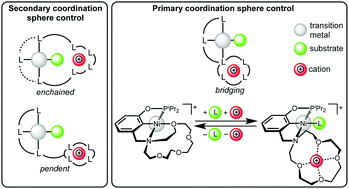Themed collection Switchable Catalysis

Photoswitchable polymerization catalysis: state of the art, challenges, and perspectives
Adjusting the length, composition, and microstructure of a polymer during the process of its formation in principle allows achieving the desired properties, thereby enabling custom-design of the thus generated polymer for its targeted function.

Chem. Commun., 2019,55, 4290-4298
https://doi.org/10.1039/C9CC01431D
Photoswitchable catalysis based on the isomerisation of double bonds
Photoswitchable catalysis is a young but rapidly evolving field that offers great potential for non-invasive dynamic control of both activity and selectivity in catalysis. This Feature Article summarises the key developments accomplished over the past years through the incorporation of photoswitchable double bonds into the structure of catalytically competent molecules.

Chem. Commun., 2019,55, 6477-6486
https://doi.org/10.1039/C9CC01891C
Cation-controlled catalysis with crown ether-containing transition metal complexes
This Feature Article reviews the structural motifs and catalytic applications of crown ether-containing catalysts and details the development of “pincer-crown ether” ligands for applications in controlled catalysis.

Chem. Commun., 2019,55, 5047-5059
https://doi.org/10.1039/C9CC00803A
Redox- and light-switchable N-heterocyclic carbenes: a “soup-to-nuts” course on contemporary structure–activity relationships
This Feature Article offers in-depth, design-to-application discussions of redox-switchable N-heterocyclic carbenes that have been field tested.

Chem. Commun., 2019,55, 4451-4466
https://doi.org/10.1039/C9CC00795D
Getting zeolite catalysts to play your tune: methyl carboxylate esters as switchable promoters for methanol dehydration to DME
Methyl carboxylate esters are found to reversibly fine tune the productivity of zeolite catalysts for making dimethyl ether from methanol.

Chem. Commun., 2019,55, 13804-13807
https://doi.org/10.1039/C9CC06334J
Switchable living nickel(II) α-diimine catalyst for ethylene polymerisation
Design and synthesis of a Ni(II) “sandwich” α-diimine complex (1) resulted in a switchable catalyst for the living polymerisation of ethylene over a range of temperatures and pressures.

Chem. Commun., 2019,55, 7607-7610
https://doi.org/10.1039/C9CC03154E
Waste not, want not: CO2 (re)cycling into block polymers
A new catalysis combining two different polymerisation mechanisms but using a single catalyst allows the efficient recycling of CO2 and block polymer formation.

Chem. Commun., 2019,55, 7315-7318
https://doi.org/10.1039/C9CC02459J
Computational mapping of redox-switchable metal complexes based on ferrocene derivatives
The properties of redox-switchable metal complexes have been captured with DFT-calculated parameters and processed into a map of chemical space, highlighting the effects of varying metals, donors, linkers and substituents in both accessible ferrocene oxidation states.

Chem. Commun., 2019,55, 7021-7024
https://doi.org/10.1039/C9CC01977D
Dual catalysis for the copolymerisation of epoxides and lactones
Using a dual catalysis approach, epoxide/lactone copolymers were synthesized with control over tacticity, molecular weight, crystallinity, and comonomer content.

Chem. Commun., 2019,55, 6914-6917
https://doi.org/10.1039/C9CC00493A
Zirconium complexes supported by a ferrocene-based ligand as redox switches for hydroamination reactions
The synthesis of (thiolfan*)Zr(NEt2)2 (thiolfan* = 1,1′-bis(2,4-di-tert-butyl-6-thiophenoxy)ferrocene) and its catalytic activity for intramolecular hydroamination are reported.

Chem. Commun., 2019,55, 5587-5590
https://doi.org/10.1039/C9CC01076A
Cooperative reduction of various RAFT polymer terminals using hydrosilane and thiol via polarity reversal catalysis
Cooperative reduction of various thiocarbonylthio polymer terminals was investigated using thiol as a polarity reversal catalyst with hydrosilane as a reducing agent.

Chem. Commun., 2019,55, 5327-5330
https://doi.org/10.1039/C9CC00900K
Redox-responsive phosphonite gold complexes in hydroamination catalysis
Very high activities were observed in the redox-induced hydroamination of alkynes by employing a redox-active gold(I) complex featuring an electron-deficient, terphenyl-substituted phosphonite-based ligand.

Chem. Commun., 2019,55, 5323-5326
https://doi.org/10.1039/C9CC01492F
Light-driven catalytic hydrogenation of carbon dioxide at low-pressure by a trinuclear iridium polyhydride complex
Under irradiation conditions, low-pressure and room-temperature hydrogenation of carbon dioxide (CO2) has been achieved using a trinuclear iridium hexahydride complex 1.

Chem. Commun., 2019,55, 5087-5090
https://doi.org/10.1039/C9CC00916G
Gold(II) in redox-switchable gold(I) catalysis
Gold(II) species catalyse the cyclisation of N(2-propyn-1-yl)benzamide to 2-phenyl-5-vinylidene-2-oxazoline without halide abstraction while the neutral gold(I) complex is inactive indicating a gold(II/I) redox-switch.

Chem. Commun., 2019,55, 4615-4618
https://doi.org/10.1039/C9CC00283A
Switchable hydrogenation with a betaine-derived bifunctional Ir–NHC catalyst
A bifunctional iridium catalyst based on the ‘uracil–abnormal NHC’ hybrid ligand platform was developed for switchable hydrogenation of quinoxalines.

Chem. Commun., 2019,55, 4574-4577
https://doi.org/10.1039/C9CC00972H
Modulation of catalyst enantioselectivity through reversible assembly of supramolecular helices
The enantioselectivity displayed by a supramolecular copper catalyst involved in successive reactions can be modulated through reversible assembly of the helices supporting the catalytic centres.

Chem. Commun., 2019,55, 2162-2165
https://doi.org/10.1039/C8CC09819K
Redox-switchable atom transfer radical polymerization
A redox-switchable ATRP was developed in which the copper catalyst, and hence the polymerization, was switched on/off using redox agents.

Chem. Commun., 2019,55, 612-615
https://doi.org/10.1039/C8CC09209E
About this collection
We are delighted to bring you this Themed Collection on Switchable Catalysis, Guest Edited by Paula Diaconescu (UCLA) & Charlotte Williams (University of Oxford). Although the term “switchable catalysts” has been used to describe various processes, we define it as multiple, catalytically active species with different reactivity generated from a single precursor in the presence of external stimuli. Because of these attributes, this research area is focused on the rapid production of molecular complexity, thereby making chemical synthesis more efficient and less costly than regular catalysis.
Switchable catalysis has many parallels in biological systems but has been less studied in the field of chemical synthesis, largely because of difficulties in regulating multiple catalytically active species to generate reactions with high levels of substrate selectivity. However, recent developments in photochemical, redox-controllable reactions, pH-responsive, and host-guest recognition have led to significant advances that have made controlling chemical reactions with switchable catalysis possible.
The versatility of these systems has led to applications that range from new organic reaction methodologies to new polymerization methods. While the ultimate goals of these processes are different, catalytic processes regulated by external stimuli share one thing: the understanding of catalyst properties as a response to the stimulus is paramount.